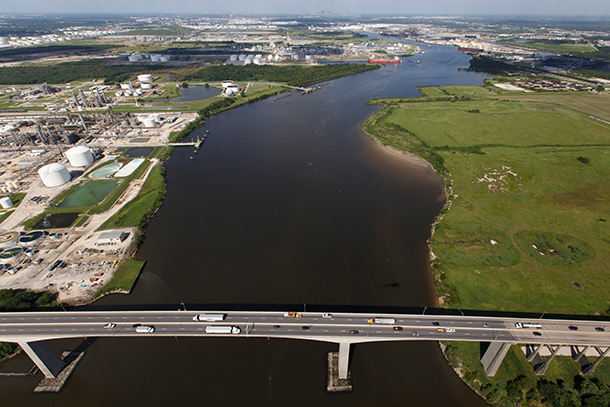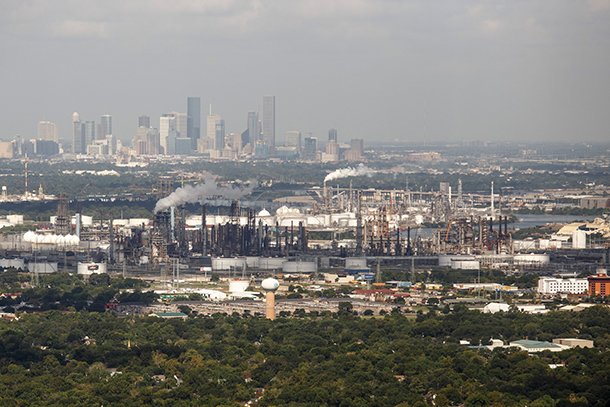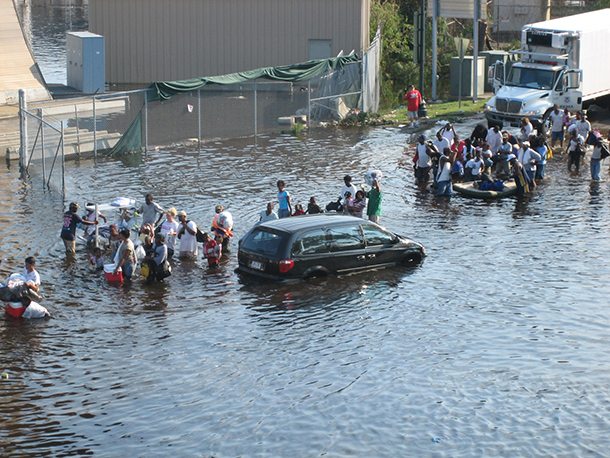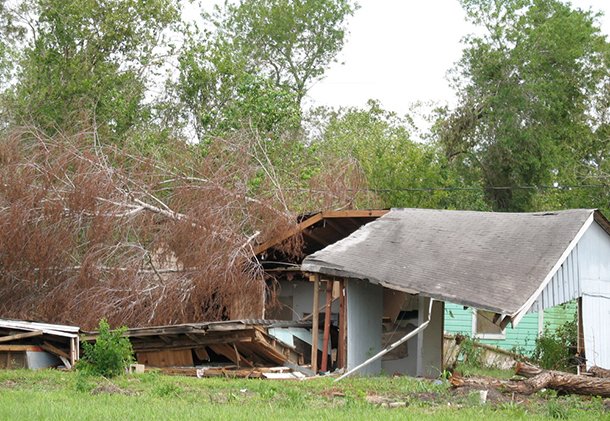Houston Hurricane Risks
Air Date: Week of June 16, 2017

The Houston Ship Channel is one of the U.S.’s busiest seaports. (Photo: Michael Stravato)
The tanks and refineries of the massive oil and gas infrastructure that Texas is famous for leave the city of Houston at risk for devastation and massive loss of life from storm surges if a major hurricane were to hit. Neena Satija of the Texas Tribune was part of the Peabody-winning team that investigated the risks, and spoke with Living on Earth Host Steve Curwood about the factors that could spell disaster, and what can be done to reduce risk.
Transcript
CURWOOD: It’s Living on Earth, I’m Steve Curwood. Hurricane season began the first of June, and forecasters expect to see 10 named storms, and three could be doozies. And for some US cities, the risk is considerable.
Take Houston, Texas, America’s fourth largest city, with a metro population of more than 6 million. Houston is home of the nation’s largest refining and petrochemical complex, vital for manufacturing jobs and our oil supply.The Texas Tribune and ProPublica recently won the prestigious Peabody Award for their joint investigation of Houston’s vulnerability to a major hurricane. By the way Galveston, Texas was supposed to become the major port on the Gulf of Mexico, but, thanks to a historic hurricane, Houston which is further up Galveston Bay, became the regional economic hub instead.
And Neena Satija with the Reveal investigative team and the Texas Tribune is here to tell us the story. Welcome to Living on Earth, Neena.
SATIJA: Thank you so much for having me.
CURWOOD: Nina, give me a brief synopsis of Houston's history with hurricanes, the major storms that have reeked havoc on the city in the past - and don't leave out Galveston.

Refinery complexes along the Houston Ship Channel in September 2016. (Photo: Michael Stravato)
SATIJA: Yeah, so Galveston actually in 1900 was a port city. It was supposed to be the Houston of America and of the world. Instead, it got pummeled by this huge hurricane in the year 1900 that killed thousands of people, and, as a result of that, Houston now exists. That really paved the way for Houston to become the port city of America.
CURWOOD: What exactly about the geography of the city puts it at risk? I understand that there's a ship channel. What does that do in a storm?
SATIJA: Right, so the thing to think about first is actually Galveston Bay, and it's almost, like, I would think of Galveston Bay as some kind of bowl. Now, when a storm is coming in from the Gulf of Mexico, that bowl starts to fill up. The water's getting higher than the rim of this bowl, and the rim is, of course, all of the beaches that are all around Galveston Bay. So, this bowl fills up, and the water spills onto the shore over the rims.
But on top of that, inside this kind of bowl, you have a, if you will, a 50 mile channel. That channel continues another 15, 20 miles or so inland. As the water gets funneled into the channel, it's an even narrower space for this water to go through, so it spills out over the edge onto land even more quickly and with even more damage.
CURWOOD: Sounds like the same situation in New Orleans where they have the Mississippi River Gulf outlet, known as the Mister Go, that was a channel that brought the storm surge of Katrina right into town.
SATIJA: Yes, definitely there's some similarities. Now, of course, New Orleans is below sea level. Houston is not below sea level. Houston is dozens of feet above sea level, but, you know, when you have the right storm hitting at the right angle, you can have that kind of effect, and of course Houston doesn't have any levies or sea wall. Galveston does have a sea wall that was built after the 1900 storm, but it's not all that high, it’s probably about 15, 17 feet high, and the scenarios we're looking at could definitely overtop that sea wall.
CURWOOD: Now, your investigation found a number of studies that projected what the storm surge would be in the Houston area from a substantial storm. Just how a big storm surge were these studies looking at?

Houston, Texas, is one of the fastest growing cities in the United States with a population of over 2 million people. (Photo: Michael Stravato)
SATIJA: It depends on where you are, but if we're looking at the Houston ship channel and some of the most industrial parts of the Houston area right along that channel, we're talking 25 to 30 feet of storm surge. Now, you know, areas along the ship channel could be anywhere from 15 to 20 feet above sea level, so the water isn't going to go 30 feet above land, but it's still going to go five or 10 feet above land.
CURWOOD: Talk to me about what's in the path of the storm surge, both in the terms of where people live but also what's there in Houston's industry.
SATIJA: Yeah, so I think what makes this probably the most important for the world and for the country to be watching is the Houston ship channel and this petrochemical complex, as it's called, petrochemical and refining complex. You have several oil refineries that are right along the Houston ship channel. If you look at a satellite view on Google maps, you'll really see how close they are to the water.
You also have a number of other types of manufacturing facilities, plastics. You know, any kind of factory that needs oil to manufacture something, it's probably along the Houston ship channel. So, we're talking about people that make tennis balls, anything with rubber, tires, Tupperware, the medicine that you take is like 99 percent pill and one percent medicine. The 99 percent of that pill, chances are, that some components of that are made along the Houston ship channel. So, all of these different industries and big manufacturing facilities and oil refineries are definitely at risk.
The other thing that’s at risk, of course, are people. We're talking about millions who live in the Houston area. Depending how you look at it, I think hundreds of thousands who might really be at risk when you're talking about flooding. Of course, hopefully they’ll have evacuated, but we've seen issues with that in the past. Certainly along Clear Lake there's a large residential population. It's very dense. It's basically the suburbs of Houston, and it's growing and growing every year. Those folks like to live on the beach. They like to live on the water. So, really, you see houses that are right up against the water, and some that really aren't all that elevated.
CURWOOD: So, what about the storage tanks, the oil and chemical storage tanks there?
SATIJA: So, we know from satellite data and scientific research, that there are thousands of storage tanks lining the Houston ship channel, and I really encourage people listening to actually go take a look at our project. It's got some satellite imagery. But also just look on Google maps. I mean, really, just go there and zoom in on the Houston ship channel, and you will see these little dots right next to the water.
Government regulations certainly do require safety measures. These tanks have to withstand pretty high wind speeds, but there's really nothing in the regulations that talk about storm surge. And what could happen with storm surge is, this rushing water could lift a tank off of its foundation, and these are huge tanks. I mean, some of them are football fields wide. They could float around. They could hit things. They could fall back down, any one of those things causing them to rupture and leak, and that's exactly what happened during Hurricane Katrina.

Residents of New Orleans seek higher ground in the wake of Hurricane Katrina. The Mississippi River Gulf Outlet, known as “MR-GO,” channeled Katrina’s storm surge right into the city – and the Houston Ship Channel could have a similar effect. (Photo: News Muse, Flickr CC BY-NC-ND 2.0)
CURWOOD: Now, back in 2008, Hurricane Ike was making its way towards the Texas coast. What happened in that case?
SATIJA: What people projected would happen was the scenarios that we're talking about now, 20, 25 foot storm surge on the Houston ship channel, 20, 25 foot storm surge on Clear Lake, thousands of people dead. Rick Perry, the governor at the time, actually spoke to my boss at the Texas Tribune and said about a million people would be dead. That's probably an overestimate, but certainly in the thousands, and people didn't evacuate. That was the other thing. Especially on Clear Lake people did not take the storm threat seriously, and they didn't evacuate, and that's why we think so many people would have died had the storm not taken the course that it did. But just a few hours before it was set to make landfall, it kind of turned at the last minute, and so it just ended up hitting a different area that didn't have the same types of risks that the Houston area had.
CURWOOD: Looking at a couple of the studies you cited in your story, it looks like the odds of a fairly serious storm in the Houston area over the next 30, maybe 50 years is about one in 10. I'm not sure I'd be willing to get on an airplane if it had a 10 percent chance of crashing. How is the city responding to this risk, if there's a 10 percent chance that it really could trash the city of Houston with a hurricane?
SATIJA: Yeah, you know, we did not get a lot of answers from the city of Houston on this. We reached out to the mayor at the time, still the Mayor, Sylvester Turner, and we got this kind of odd statement back basically saying, “We're really more worried about wind damage within the city of Houston's borders. You know, storm surge isn't a big deal for us”.
This really doesn't make a ton of sense, just scientifically. Parts of Clear Lake are in the city of Houston within the city's borders, so storm surge does matter to them, but, of course, even if you have an entire town flooded that's right on the border of the city of Houston, you're going to have problems. People aren't going to be able to get to work. People aren't going to be able to get to the hospital. So, it didn't really seem like they wanted to engage, frankly, on this issue.
Now, the former mayor of Houston Annise Parker did make a big deal of this. Her way of looking it, I think, is, you've got, you know, thousands of people moving to Texas a day, many of them moving to Houston. Some of them are moving from coastal areas - California, New York - but some of them are moving from places where they don't know anything about hurricane risk, and you're going to have to convince them to engage on this issue, to pay for this issue, and that's going to be a really really tough thing to do.
CURWOOD: Yeah, so how aware are people in Houston that the odds are, say, about one in 10 that the city could get really whacked with a tough hurricane over the next 30 or 50 years?
SATIJA: I don't think most people are aware. It's certainly something that a lot of real estate agents don't want to talk about. People who have lived their whole lives in Houston, have been there for decades, are a lot more aware. But it's funny, even though people like that that we spoke to were certainly aware, they were also like, “This is never going to happen", right?” I mean, imagine living in Houston for 30 years and getting this kind of warning every couple of years, every summer, that there's going to be a big one and it doesn't hit, and that's what makes this actually even more dangerous. When people don't take the threat seriously, that means that when it finally does you really have a big problem.
CURWOOD: So, what kind of plans have been developed by the city and the region to deal with this threat, and what kind of progress in those plans has been made since you published your report?
SATIJA: I'd say the main progress, since we’ve published our investigation, is there's been more talk about the need to build a barrier of some kind. I don't think anyone has yet completely agreed on what should be built, but everyone does seem to now agree, we need to build a storm surge barrier for the Houston area, and they have some consensus on what it should look like.
It's going to kind of go probably between Galveston and Bolivar islands. It's going to cross a little section of Galveston Bay. It's going to be a large gate of some kind, and it's going to probably cost essentially more than $20 billion to build. Some progress has been made on actually planning how that barrier should be built, what it should look like. President Obama signed a law last December that included some language that could help expedite this process of doing a study. Even then, it's probably going to take five or 10 years to build, something like that. So, not much else has been done, that we're aware of, to protect the city and the region in the meantime.

Damage caused by Hurricane Ike in 2008. (Photo: PINKE, Flickr CC BY-NC 2.0)
CURWOOD: You suggested a barrier wall would cost $20 billion. How much damage would be done by major storm there in Houston if there isn't such a barrier? What's the estimate for that?
SATIJA: I think the estimate is around $100 billion, potentially more than $100 billion. So, Ike cost about $30 billion of damage, that's the estimate. I would think Katrina and Sandy were both on the order of $100 billion in damage as well. So, we're looking at, you know, one of the most costly storms that we've ever had in this country, in modern history. That's no question. If we get one of these direct hit storms, category 4 or 5, you know, high enough wind speed hitting at the right angle, we will have thousands of deaths.
CURWOOD: Now, I don't want to sound callous, in fact, my dad was from Houston and I have cousins in the area, but this is disastrous for Houston if something happens. What about the rest of America?
SATIJA: I think it's certainly disastrous for the rest of America. I mean, even Katrina, we saw increased gas prices for a long time even after hurricane Ike, in fact, we saw an increase in gas prices nationwide. But, really, if you have that direct hit type of scenario on Houston, in the Houston area, you're going to see -- we've heard economist tell us, $7, $8, $9 a gallon gas for months because you're talking about some of the nation’s largest refineries, in fact, the nation's largest refineries on the Houston ship channel potentially, if not being damaged, at least having to go offline for months at a time.
CURWOOD: So, some sort of a barrier wall is $20 billion and a number of years away. What are the most important changes the city could make right now to protect its citizens even before this barrier goes up?
SATIJA: We've talked to a number of cities and counties and the state on this and they say, "Well, we do the hurricane preparedness drills. Ycan go to our website". I'm not convinced that people, especially the people who are moving to the area, that are new to the area, are aware of the risk. We've talked to people who have moved into a 100-year flood zone and didn't know. So, certainly more could be done on awareness.

Neena Satija is a reporter and radio producer for the Texas Tribune and Reveal, a public radio program from the Center for Investigative Reporting. (Photo: Texas Tribune)
The second thing that these cities and towns could be doing is updating, changing their building codes, changing their building regulations. That's not probably going to protect against the type of storm scenario that we're talking about, you know, the one in 500 storm a year, but it will certainly protect against the smaller storms, the floods that Houston's getting sometimes two or three times a year right now.
Some cities did update their building codes after Ike to increase minimum elevation, but really not much else was done. There's a huge amount of development happening in Houston and the surrounding areas. Houston doesn't have any zoning. It's just not something that's talked about very much, so I do think that...You know, we talked to many scientists who said that, "Look, there are things we can do beside build a storm surge barrier".
I think the barrier at this point has become a way of saying, we can reach out to a government or an industry and say, "Hey, what are you doing to prepare for hurricanes", and they say, "Oh, we're supporting a storm surge barrier". It doesn't really make a lot of sense for your public in the next 10 years. It's great to support the storm surge barrier, but there's something that you need to be doing right now.
CURWOOD: To what extent it is a major hurricane disaster going to hit poor people harder than rich people, or this is an equal opportunity disaster waiting to happen?
SATIJA: Well, it's funny you asked me that. I still remember...That just reminds me of an interview that we did in Galveston, where we spoke to a couple who lived in a really nice kind of beach home and they didn't evacuate. They were OK, thankfully, but they did, you know, get stuck on the island for a while, and they remember having to stand in line to get sort of their rations at a FEMA tent or something like that, and it was just all different walks of life types of people standing in this line and they were really struck by the equalizing factor that a storm has.
But certainly people who are poor are, I think, going to be affected more especially because a lot of those folks live in these industrial towns along the Houston ship channel. They're the ones who live closer to these refineries, to these facilities. If they can't evacuate, I think they are at greater risk of not just flooding, but something worse happening and then actually still being at home to experience that and suffer through that. Of course, on the evacuation side, you know, if you don't have a car, evacuating is going to be really difficult. Depending on where you live, how far you live from the highway, evacuating is going to be really difficult, but people who are the most vulnerable are going to be the ones that are going to have trouble decorating that's probably the scariest part of this.
CURWOOD: Neena Satija is a reporter with the Reveal Center for Investigative Journalism and the Texas Tribune. Nina, thanks for taking the time with us today.
SATIJA: Thanks a lot, Steve.
Links
ProPublica: The Full Investigative Report
Reveal | The Reveal podcast on the Hurricane risk in Houston
Living on Earth wants to hear from you!
Living on Earth
62 Calef Highway, Suite 212
Lee, NH 03861
Telephone: 617-287-4121
E-mail: comments@loe.org
Newsletter [Click here]
Donate to Living on Earth!
Living on Earth is an independent media program and relies entirely on contributions from listeners and institutions supporting public service. Please donate now to preserve an independent environmental voice.
NewsletterLiving on Earth offers a weekly delivery of the show's rundown to your mailbox. Sign up for our newsletter today!
 Sailors For The Sea: Be the change you want to sea.
Sailors For The Sea: Be the change you want to sea.
 The Grantham Foundation for the Protection of the Environment: Committed to protecting and improving the health of the global environment.
The Grantham Foundation for the Protection of the Environment: Committed to protecting and improving the health of the global environment.
 Contribute to Living on Earth and receive, as our gift to you, an archival print of one of Mark Seth Lender's extraordinary wildlife photographs. Follow the link to see Mark's current collection of photographs.
Contribute to Living on Earth and receive, as our gift to you, an archival print of one of Mark Seth Lender's extraordinary wildlife photographs. Follow the link to see Mark's current collection of photographs.
 Buy a signed copy of Mark Seth Lender's book Smeagull the Seagull & support Living on Earth
Buy a signed copy of Mark Seth Lender's book Smeagull the Seagull & support Living on Earth

